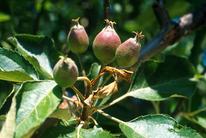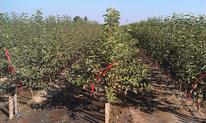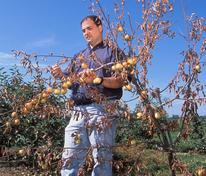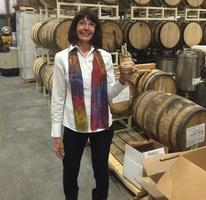By Michelle Miller
Edited by Kristine Moncada, Craig Sheaffer, Gigi DiGiacomo and Nicole Tautges
“I could be pushed into a corner if I have to choose between my orchard and organic certification. If National Organic Program-acceptable and effective controls for fire blight are not found, I may not have an orchard left to certify.” Deirdre, like many orchardists, is facing difficult choices when fire blight hits. Fire blight, caused by the bacteria Erwinia amylovora, spreads like wildfire through trees. A major tool to control fire blight is the antibiotic streptomycin that was allowed in organic production only under the strictest of conditions. The National Organic Standards Board signaled it intended to remove antibiotics from use in organic orchards altogether, but organic apple growers had no proven, alternative strategy to control fire blight.
Deirdre and her husband John Biondi are second-career orchardists. Deirdre grew up in suburban Chicago, but always had an interest in farming. In graduate school, she took leadership roles in the student sustainable agriculture organization. After obtaining her joint Ph.D. degrees in Land Resources and Adult Education, she worked primarily in Africa with nonprofit agricultural organizations. She had many leadership roles, including directing Georgia Organics, serving as board President for the Organic Farming Research Foundation, and chairing the UW-Center for Integrated Agriculture’s Citizen Advisory Committee.
Still, her heart was in farming, and so in 2002, she and her husband purchased a farmstead in Wisconsin’s Driftless Region, with the intent to raise organic apples for hard cider and brandy production. “I have three degrees in agriculture, but somehow didn’t take a single class in horticulture” Deirdre remarked.
In 2003, Deidre began an intensive period of learning the orchard business, with an eye to raising traditional English and French cider apples. These apple varieties are like the wine grapes of apples due to their tannin and acid profiles. They yield a more complex, full body, and aromatic cider. She soon learned that orchardist Dan Bussey lived nearby and shared her interest in unique apple varieties. He taught her to graft, shared scion wood from his trees, and the two split rootstock orders.
On her hunt for learning opportunities, Deirdre saw that there was a lack of information specific to organic tree fruit production and so she helped organize a network for organic apple growers. Here Deirdre met and was mentored by farmer-innovator Jim Koan, from Michigan. Deirdre also worked with the University of Wisconsin to establish apple IPM conference calls targeted to organic fruit producers. These weekly calls helped her gain invaluable insight into pest management specific for her operation.
In 2006, Deirdre planted her first 800 trees in a block, and started a nursery with an additional 300 trees. Her intention was to borrow a tree planter, but when it was unavailable she found herself, with a little help from friends, digging 1,100 holes with shovels. She planted more trees every year, having to replace whole rows of trees wiped out by fire blight. Her goal was to plant 1,500 to 4,000 trees annually to get the orchard to 20,000 trees primarily of true English and French cider apples. To reach this goal, she maintained a hoop house for propagation, using Jim Koan’s system of hoophouse tree propagation while also contracting with tree nurseries to custom graft trees for her.
Growing organic apples in the humid Midwest is risky, and a major challenge is disease. The true cider apples are particularly prone to fire blight infection. Early on, Deirdre culled the apple variety most prone to fire blight, and introduced two disease-resistant, tart apples developed in the US and recommended by the former pomologist and cider maker at Cornell University, Ian Merwin. Liberty and Priscilla proved to be excellent acidic apples that blend well with the tannic cider apples.
Finding Fire Blight
With the first blossom comes the first evidence of fire blight. In 2008, two years after initial plantings, a major fire blight infection hit Deirdre’s young orchard. The first evidence of disease was flower stamens oozing orange. The disease enters the stamens when weather conditions are right. Warm, rainy, windy spring days during bloom leave the trees wide open to disease. Droopy tender new shoots indicate that the disease is spreading, and if tree trunks start to ooze, it is time for drastic measures. To slow the spread of disease, Deirdre cut and burnt whole trees. After cutting down the first one hundred trees, she stopped counting. Young trees less than ten years old are most susceptible, meaning all her true cider apples were in harm’s way.
Apples are a high-value, capital-intensive crop and growing them organically reduces the options for contending with disease. Cutting down trees as a means to protect other trees from disease amounts to losing the capital invested to grow those trees. And Deirdre faced the additional challenge of potentially losing the only disease prevention tool in her tool-box – antibiotics, especially streptomycin.
Fire blight is endemic in the natural environment. That is, it is widely found in soils, and lives on wild hosts, such as apples, hawthorne, plum, and other trees in the rose family. As Deirdre explained, it is “a sleeper disease” that could “wake up” and appear whenever conditions were right. Fire blight is a serious threat to commercial apple production, conventional or organic. Michigan growers have lost millions of dollars to region-wide fire blight infections, to the point where fire blight in Michigan has developed antibiotic resistance to streptomycin. Washington State organic growers also saw fire blight resistance to streptomycin and had switched to another antibiotic – oxytetracycline. It is precisely this issue of antibiotic resistance that was of concern to the National Organic Standards Board (NOSB).
Alternatives to Antibiotic Use
The NOSB regularly reviews all pest control chemistries used for certified organic production, and in the spirit of continual improvement, will restrict chemicals and eventually phase them out if the Board deems them unnecessarily risky to human or environmental health. With antibiotics, the concern is that disease-causing pathogens will become resistant and will no longer be controllable with antibiotics. Streptomycin is a restricted use chemical in organic production so farmers wanting to use it must show cause. In Deirdre’s case, cause was clear. She could lose the very varieties that distinguish her brandy and ciders if she didn’t have access to streptomycin.
As NOSB continued to debate the status of streptomycin as an allowable disease prevention tool, Deirdre started looking for alternatives. Apogee (prohexadione-calcium) is a synthetic product that conventional growers may use. It thickens cell walls so that shoots are less vulnerable to attack, but it is not allowed in organic production. She kept abreast of on-going research at Oregon State University and Washington State University on alternative strategies. Similar research trials in Michigan were not yielding the same results as research in western states, likely due to the more humid weather conditions. Meanwhile, Deirdre had invested a lot of time in weekly examination of each and every tree for infected shoots, and removing infected shoots and whole trees from the orchard.
Deirdre started experimenting with additional copper sprays beyond early spring, including at blossom. She relied on her mentors to improve her use of copper as a disease control tool, but was uncertain if copper would be effective from one disease window to the next. Copper, a heavy metal, was an allowed chemical in organic production, but caused fruit russetting – a discoloration that doesn’t affect fruit quality but affects marketability. Because she was processing all her apples, she was not concerned about fruit russetting. Newer products that have lower levels of copper or can complement a disease program including copper and, while expensive, can be sprayed more frequently without accumulating in the soil.
Other options that Deirdre considered for her orchard were biologicals that became newly available for organic production. Serenade Optimum (QST 713 strain of Bacillus subtilis) showed promise in western orchard research. Blossom Protect (Aureobasidium pullulans) was a yeast that, when used as part of a treatment program of lime sulfur & fish oil, followed by Blossom Protect, followed by a soluble copper was very effective at controlling fire blight in western orchards. The efficacy of such new treatments was unknown in the Upper Midwest and were more expensive to growers than antibiotic treatments.
Should Deirdre build her business as an organic cider company, given her ongoing struggles with fire blight? If she chooses to switch to a conventional growing model to increase her options for disease control, what will she lose? Or should she discontinue growing the true cider varieties that distinguish her products but are prone to fire blight, what are the tradeoffs?
Access the complete decision case with all educational materials (pdf) >>>
You may cite this publication as:
Miller. M. 2017.Fighting Fire Blight.A Decision Case Study in Principles for Transitioning to Organic Farming: e-Learning Materials and Decision Case Studies for Educators. K. Moncada, C. Sheaffer, G. DiGiacomo, and N. Tautges (Eds). University of Minnesota, St. Paul, MN.



